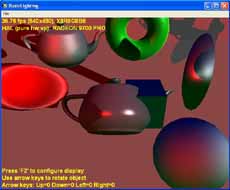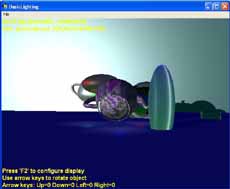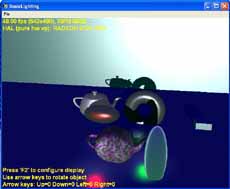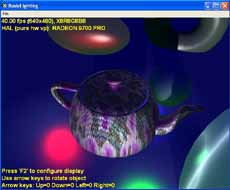Conclusions
Deferred Lighting is now possible in hardware on the latest video cards, it has an own unique advantages and disadvantages and while in many cases the disadvantage out way the advantages on current hardware in the right situations it can outperform and look better than conventional per-pixel lighting. In situations with complex procedural shaders with many lights and shadows, the saving can be massive this is even truer in densely occluded environments. The same techniques used to accelerate objects (batching etc) can be used to accelerate lights, and if a light isn’t visible its cost is very low.
In the long term the occlusion and geometric properties of deferred lighting are its most interesting factors, no other technique allows you to render so many lights affecting a single surface without crippling performance, with deferred lighting it scales much better.
Biblography
- T. Saito and T. Takahashi. "Comprehensible Rendering of 3-D Shapes". Computer Graphics (SIGGRAPH '90 Proceedings), Vol. 24, No. 4 1990
- Perlin, Ken, An Image Synthesizer, Computer Graphics, Vol. 19 No. 3 1985
- 3. Jason Mitchell, Real-Time Image-Space Outlining for Non-Photorealistic Rendering - SIGGRAPH 2002
- 4. Marc Olano and Anselmo Lastra, A Shading Language on Graphics Hardware: The PixelFlow Shading System. In Proceedings of SIGGRAPH 98
- James Blinn, Jim Blinn's Corner: A Trip Down the Graphics Pipeline, Morgan Kaufmann, 1996
- Nicolas Thibieroz, Deferred Shading with Multiple Render Targets. ShaderX2 - Shader Tips & Tricks
- PIXAR. The RenderMan Interface Specification: Version 3.1. Pixar Animation Studios, September 1999.
- John Carmack, Plan files on Doom 3 renderer
- B. T. Phong. Illumination for computer generated pictures. Communications of the ACM, 18(6):311--317, 1975
- 10. J. F. Blinn. Models of light reflection for computer synthesized pictures. Computer Graphics, 11(2):192--198, 1977
- Microsoft. Direct3D Immediate Mode. From the DirectX 9 SDK
- Segal, Mark and Kurt Akeley, The OpenGL Graphics System: A Specification (Version 1.0), Silicon Graphics Incorporated, 1993
- Atari ST 3D Graphics, Abacus Software Book 12
- 14. Mark Kilgard Shadow Papers (Various)
- Möller and Haines,Real-Time Rendering A. K. Peters, 1999. ISBN 1-56881-101-2
- Hansong Zhang, A Traditionalist View of 3-D Image Warping
- ATI Shadow Map Demo
- DEBEVEC, P. Rendering synthetic objects into real scenes: Bridging traditional and image-based graphics with global illumination and high dynamic range photography. In SIGGRAPH 98 (July 1998)
- G Riguer, Pixel Shader V2 Depth Of Field Power Point Presentation For ATI 9700
- NVIDIA Cass Everrit Order independent transparency
Source code and executables are now available here. Remember, at present this is likely to only work on Radeon 9500 and above do to the reliance on high precision render-targets, which are not supported by current GeForce FX drivers.




